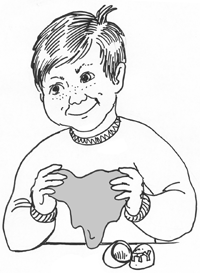STRANGE BUT TRUE- Not silly: There's gold in that plastic egg

DRAWING BY DEBORAH DERR McCLINTOCK
Q. At times it'll act like a liquid, at times like a solid. It can flow, bounce, stretch when pulled slowly or break if pulled fast. What were General Electric scientists trying for with their multi-faceted creation?–A.M. Professor
A. An inexpensive substitute for rubber, but there were a few drawbacks: The stuff never held a shape and broke when you hit it, say Vicki Cobb and Kathy Darling in their book We Dare You!
Still, the flexible goo stretched farther, bounced higher, and resisted mold and decay. Even weirder, it could lift print off newspaper pages, collect cat fur and lint, clean ink off typewriter keys, and help level wobbly furniture. Yet after 50 years, no one– including some of the world's leading engineers– ever came up with a really practical use for it. In a last-ditch flash of creativity, the company named it Nutty Putty (later Silly Putty) and made a small fortune selling it as a toy.
Q. They can weigh more than half a kilogram (about a pound), tasting a bit like a piece of veal and with recipes available for making them up into "meat" loaf, even smoothies. So why have vegetarians taken such a fancy to them? Clue: Tom Cruise famously announced his intention to eat one.–K. Holmes
A. Cruise was talking about his expectant wife's placenta, Nature's remarkable organ for the developing fetus that acts as substitute lungs, stomach, liver, bladder, says Katherine Robertson of the University of Cambridge, UK, in New Scientist.
Cells known as trophoblasts hijack the maternal blood system to provide the baby with needed oxygen and nutrients, serving as a protective barrier against Mom's immune system that might otherwise reject the growing mass. For certain vegetarians, the placenta affords the rare opportunity to eat meat without necessitating a slaughter of any kind.
True enough, concurs Robertson, who suggests that the life-giving placenta be both celebrated and investigated by researchers. "But I must confess an embarrassing failure of nerve when it comes to placental lasagna..."
Q. How was Albert Einstin luckier than Hermann Minkowski, Charles Darwin luckier than A.R. Wallace, and Dmitri Mendeleev luckier than J.L. Meyer?–S. Hawking
A. Luckier in the annals of scientific history, that is, says the Princeton Review. August names such as Mendeleev (periodic table of the elements), Darwin (evolution), and Einstein (relativity) are household names for many of us, whereas the unlucky Minkowski, Wallace, and Meyer have been relegated to the dustbin of science history, known only to the most diligent of scholars.
Yet the latter trio independently developed theories on the periodic table, evolution, and relativity, often at practically the same time as their better-known contemporaries. It is a mere whim of historical chance that we wind up remembering some scientists but not others who are of equal importance.
Q. What if a 90 percent basketball free-throw shooter tried to match the world record of 5,221 baskets in a row from the line set by Ted St. Martin in 1996? Would his chances be slim or none?–R. Sampson
A. Our hard-working computer says that even for a rapid-fire 90 percent shooter taking a shot every second, it would take him more than a googol years (1 followed by 100 zeros), on average, to match Ted's record, obviously an impossible feat. So 5'7" St. Martin, though not a pro, was clearly way, way better than a 90 percent shooter. (The NBA record for consecutive free throws is only 78.)
For a much stranger record, Fred L. Newman once made 88 consecutive baskets from the line while blindfolded! Matching this one would take the wide-eyed 90 percent shooter an average of about 30 hours to accomplish.
Q. How long is the coastline of Great Britain? a) about 5,000 kilometers (3,000 miles) b) 15,000 kilometers c) as long as you'd like it to be.–W. Churchill
A. The startling answer is c). Let's say you start with a coarse almanac map and lay a string along the coast as best you can, then measure it and multiply using the distance scale of the map. You get roughly 4,000 kilometers. Next you get out your atlas and measure again. Your answer will be bigger than before, including bays, promontories, etc. At the library, you use an even more detailed map, and the length jumps again. Can you see the drift here? There is no true length of the coast! Even if you go to Great Britain and measure the coast by first driving, then walking around it, your measured lengths will depend on the "ruler" you use.
Now imagine a dog walking around it, exploring every byway, or a mouse. The coastal length will grow without limit because it has a "fractal" shape, naturally craggy instead of straight and revealing ever new detail under magnification.
~
Send strange questions to brothers Bill and Rich at [email protected].
#
1 comment
Amazingly stupid column!!! Ironic too that they refer to influential scientists whose names are not commonly known in the answer to one "question" and then they don't give Mandelbrot credit in the one about fractals. PhD in what I wonder.